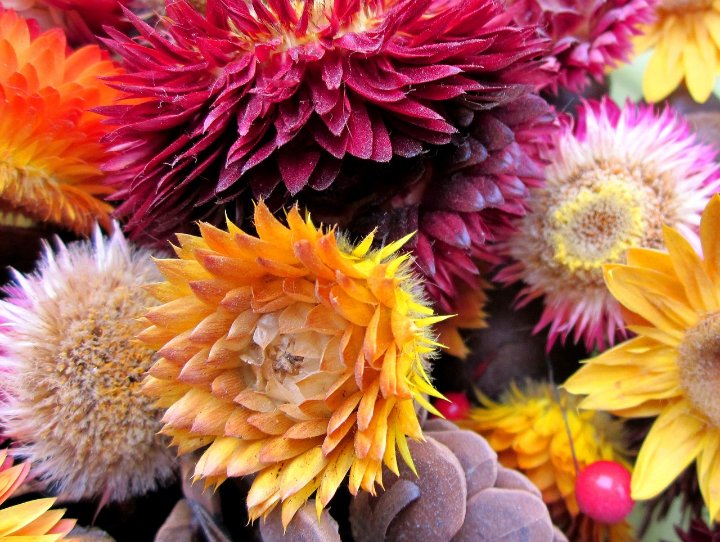Strawflowers, with their papery petals and vibrant colors, add a delightful touch to any garden or floral arrangement. If you’re looking to cultivate these charming blooms in your garden, here’s a comprehensive guide on how to grow and care for strawflowers.
Best Strawflowers Varieties
| Image | Name | Rating | Shop |
|---|---|---|---|
 | Burpee Tall Mixed Colors Strawflower Seeds |  | |
 | Dwarf Strawflower Seeds Mix |  | |
 | Purple Helichrysum Paper Daisy Flower Seeds |  |
Strawflowers Hardiness Zones
Strawflowers thrive in USDA hardiness zones 8 to 11. These regions offer the ideal conditions for strawflowers to flourish, with mild winters and warm summers providing the perfect environment for robust growth and abundant blooming.
How Much Sun Do Strawflowers Need
Strawflowers prefer full to partial sun exposure to thrive. Plant them in a location where they will receive at least six hours of sunlight per day. Adequate sunlight ensures sturdy stems and vibrant blooms, allowing you to enjoy the beauty of your strawflowers throughout the growing season.
Strawflowers Soil Requirements
Well-drained soil is essential for the successful growth of strawflowers. Choose a planting site with fertile, loamy soil that drains well after watering. Amending the soil with organic matter such as compost or aged manure can improve its texture and fertility, providing an ideal growing environment for your strawflowers.
Strawflowers Soil pH
Strawflowers prefer neutral to slightly acidic soil pH, ideally ranging from 6.0 to 7.0. Testing the soil pH before planting can help you make any necessary adjustments to ensure optimal growing conditions for your strawflowers.
Strawflowers Plant Spacing
When planting strawflowers, space them approximately 2 to 3 feet apart, allowing enough room for their mature size. Strawflowers typically grow to heights of 2 to 3 feet and spread 6 to 18 inches wide, so providing adequate spacing ensures proper air circulation and prevents overcrowding, which can lead to disease issues.
Strawflowers Water Requirements
Despite their delicate appearance, strawflowers are surprisingly drought-tolerant once established. Water your strawflowers sparingly, allowing the soil to dry out between waterings. Overwatering can lead to root rot and other moisture-related issues, so it’s essential to strike the right balance to promote healthy growth.
Strawflowers Temperature Requirements
Strawflowers thrive in cool spring and early summer temperatures. Plant them in the spring after the last frost date for your region to ensure optimal growing conditions. Avoid planting them in areas prone to extreme heat, as this can cause stress and reduce blooming.
Strawflowers Humidity Requirements
Strawflowers prefer low humidity environments and may struggle in regions with high humidity. Plant them in well-ventilated areas with good air circulation to minimize humidity-related issues. Avoid overhead watering, as this can increase humidity levels around the plants and promote disease development.
Strawflowers Fertilizer Requirements
Strawflowers benefit from monthly applications of balanced flower fertilizer during the growing season. Choose a fertilizer specifically formulated for flowering plants and follow the manufacturer’s instructions for application rates. Avoid over-fertilizing, as this can lead to excessive foliage growth at the expense of flowers.
Strawflowers Pests
Strawflowers may be susceptible to pests such as leafhoppers, which can cause damage to the foliage. Monitor your plants regularly for signs of pest activity and treat affected areas promptly with insecticidal soap or neem oil. Providing a diverse garden environment with beneficial insect-attracting plants can help naturally control pest populations.
Strawflowers Diseases
Strawflowers may be susceptible to diseases such as aster yellows, which can cause stunted growth and distorted flowers. To prevent disease issues, ensure proper soil drainage, provide adequate air circulation, and avoid overhead watering. Remove and destroy any infected plant material promptly to prevent the spread of disease.
By following these guidelines for growing and caring for strawflowers, you can enjoy a stunning display of colorful blooms in your garden throughout the growing season. With their resilience and beauty, strawflowers are sure to become a cherished addition to your outdoor landscape.
















